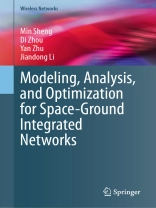This book delves into the burgeoning field of space-ground integrated networks (SGINs), focusing on the evolution, architecture and application scenarios of large satellite constellations. As global communication demands surge, the next-generation SGINs are transitioning towards large-scale, hyperscale, and hierarchical constellations to address diverse user needs, such as ultra-long-haul, high-speed and instantaneous communications. Through an in-depth exploration of network working principles, traffic and link modeling, and performance analysis and optimization methods, this book offers substantial guidance to readers. It aims to uncover pathways for enhancing network service capability and to establish a solid theoretical foundation for the future development of mega-satellite constellations within the SGIN framework.
Furthermore, this book provides a comprehensive analysis of SGINs, examining its network architecture, developmental trajectory and application scenarios. It delves into the core challenges faced by SGINs and proposes response strategies. This book introduces various methods for service capability modeling and quantitative performance analysis across different traffic types, emphasizing the intricate relationships between network performance, traffic patterns, nodes, links and network characteristics. Through an exhaustive study of large-scale satellite network operations, this book illuminates avenues for improving network service capacity, thereby paving the way for theoretical guidance and technical support for future ultra-large-scale SGINs. By offering systematic analyses and insights, this book aims to equip readers with a profound understanding and practical guidance for SGIN network planning and optimization. It also highlights future trends and potential application scenarios in the evolving landscape of network technology.
This book targets advanced level students, professors, researchers and scientists working in the fields of telecommunications, satellite communications and network engineering, who wish to gain an in-depth understanding of SGIN principles, performance analysis and optimization techniques. Practitioners working in aerospace or telecommunications policy making to gain insights into future trends and challenges in satellite network design and optimization will want to purchase this book as well.
Table of Content
Introduction.- Modeling for SGINs.- Performance analysis for SGINs.- SGIN performance optimization.- Prospects for SGINs with mega satellite constellations.
About the author
Min Sheng, (Senior Member, IEEE) received the M.S. and Ph.D. degrees in communication and information systems from Xidian University, Shaanxi, China, in 2000 and 2004, respectively. She is currently a Full Professor and the Director with the State Key Laboratory of Integrated Service Networks, Xidian University. Her research interests include mobile ad hoc networks, 5G mobile communication systems, and satellite communications networks. She is a fellow of the China Institute of Electronics (CIE) and the China Institute of Communications (CIC). She was awarded as a Distinguished Young Researcher from NSFC and a Changjiang Scholar from the Ministry of Education, China, respectively.
Di Zhou, (Member, IEEE) received the B.E. and Ph.D. degrees in communication and information systems from Xidian University, Xi’an, China, in 2013 and 2019, respectively. She was also a Visiting Ph.D. Student with the Department of Electrical and Computer Engineering, University of Houston, from 2017 to 2018. She is currently an Associate Professor with the State Key Laboratory of Integrated Service Networks, Xidian University. Her research interests include dynamic resource allocation, mission planning, and performance evaluation in space-terrestrial integration networks and space information networks.
Yan Zhu, received the B.E. degree in Telecommunications Engineering from Xidian University, Xi’an, China, in 2015, where he received the the Ph.D. degree in Communication and Information Systems and joined as a lecturer. He is also a visiting Ph.D. student in the Electrical and Computer Engineering Department at the University of Houston, USA. His research interests focus on network modeling, performance analysis, and resource allocation in wireless communication networks.
Jiandong Li, (Fellow, IEEE) received the M.S. and Ph.D. degrees from Xidian University in 1985 and 1991, respectively. He has been a Faculty Member with the School of Telecommunications Engineering, Xidian University, since 1985, where he is currently a Professor. He was a Visiting Professor with the Department of Electrical and Computer Engineering, Cornell University, from 2002 to 2003. His research interests include wireless communication theory, cognitive radio, and signal processing. He was a member of Personal Communications Networks (PCN), Specialist Group for China 863 Communication High Technology Program, from January 1993 to October 1994 and from 1999 to 2000. He is also a member of the Specialist Group of the New Generation of Broadband Wireless Mobile Communication Networks for the Ministry of Industry and Information Technology. He is a fellow of the China Institute of Electronics (CIE) and the China Institute of Communication (CIC). He was awarded as a Distinguished Young Researcher from NSFC and a Changjiang Scholar from the Ministry of Education, China, respectively. He served as the General Vice Chair for the 2009 China Com and the TPC Chair for the 2013 IEEE ICCC. He is the Chair of Broadband Wireless IP Standard Work Group, China.












